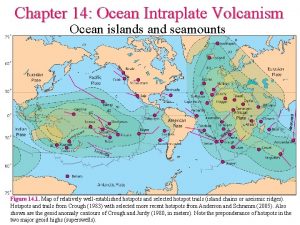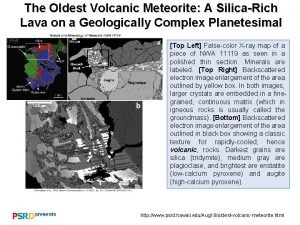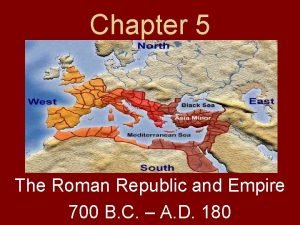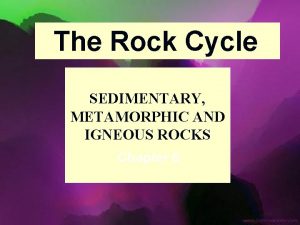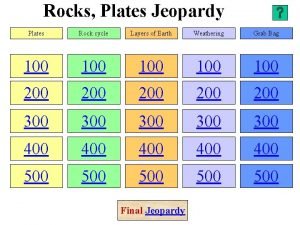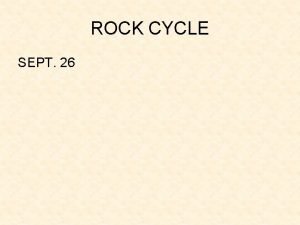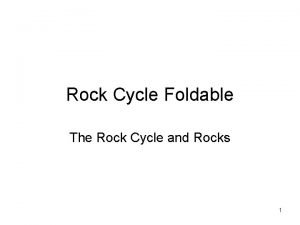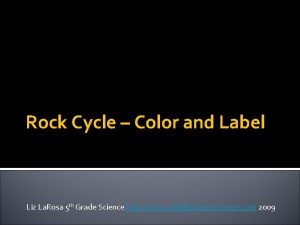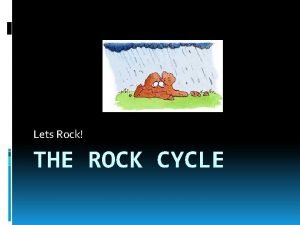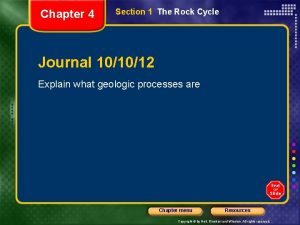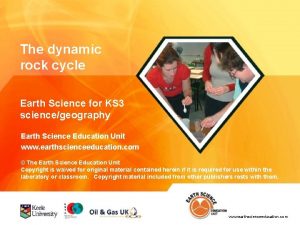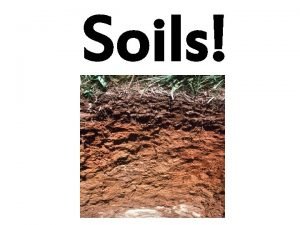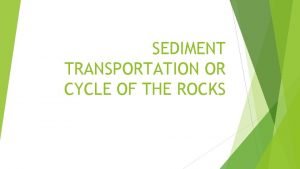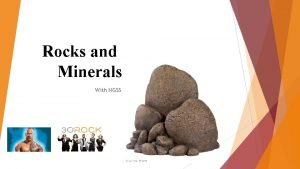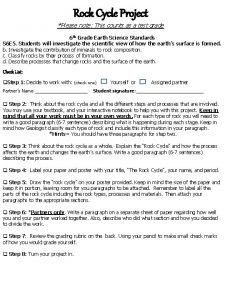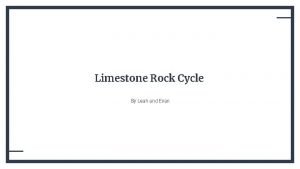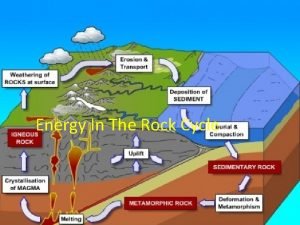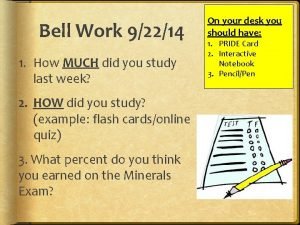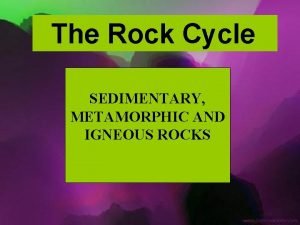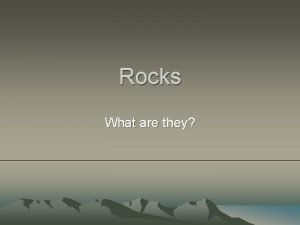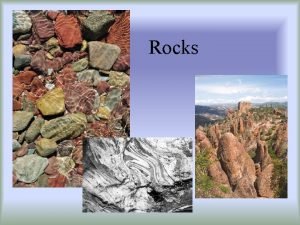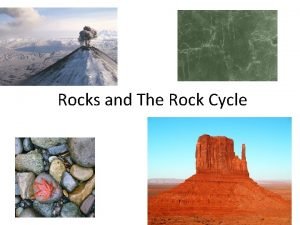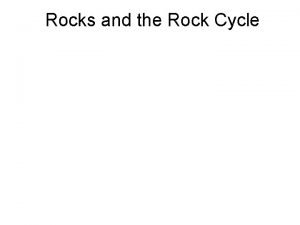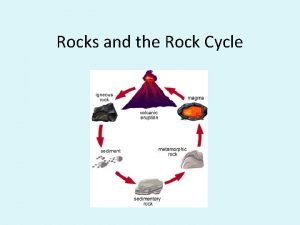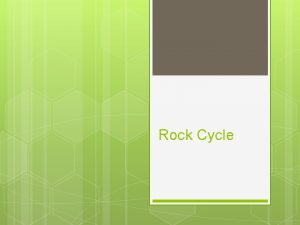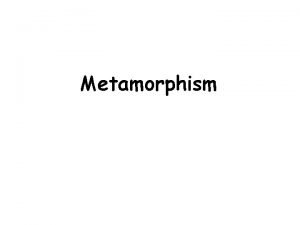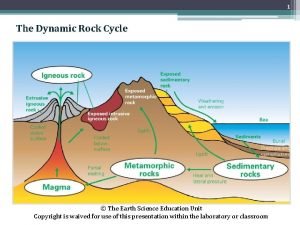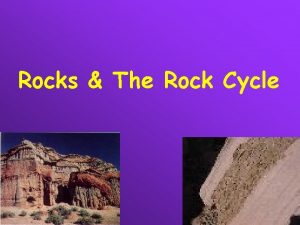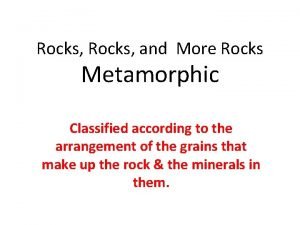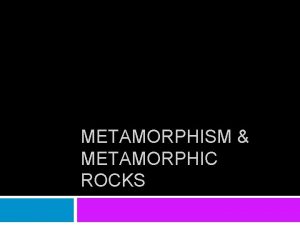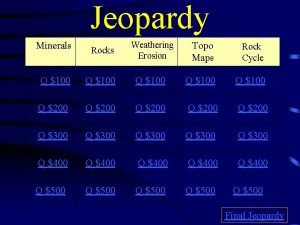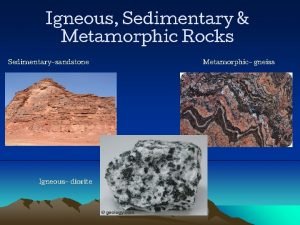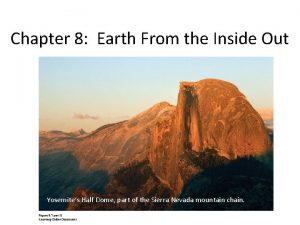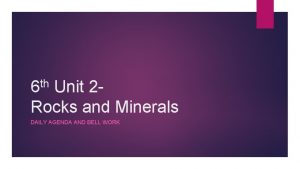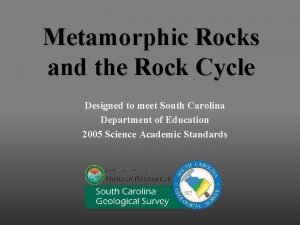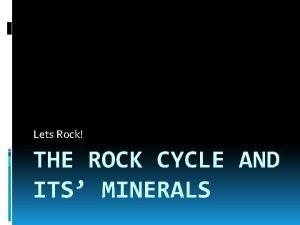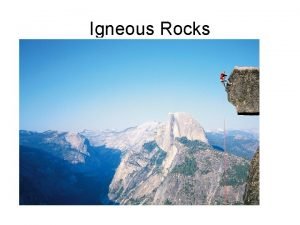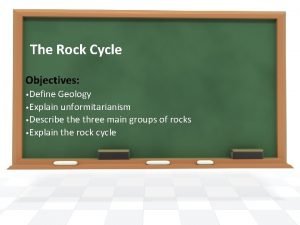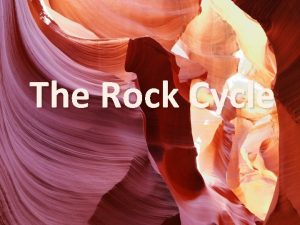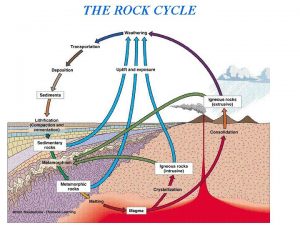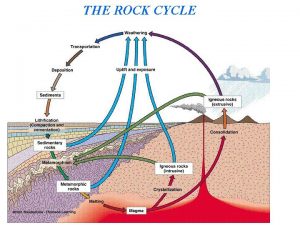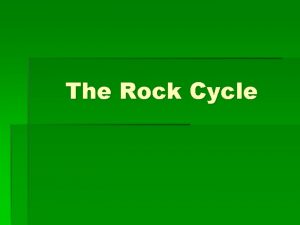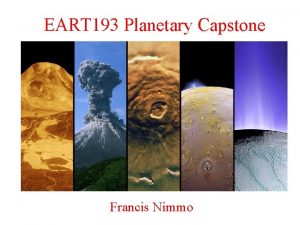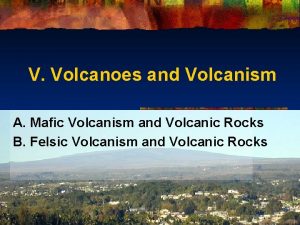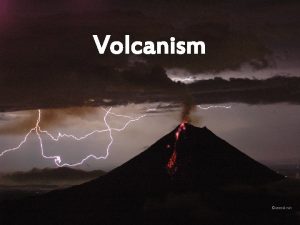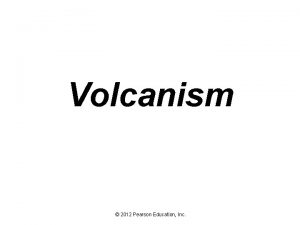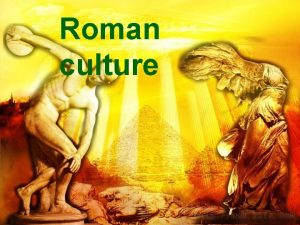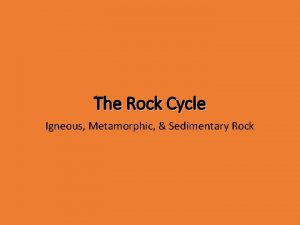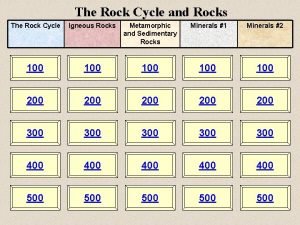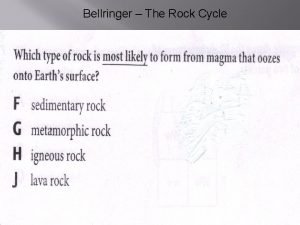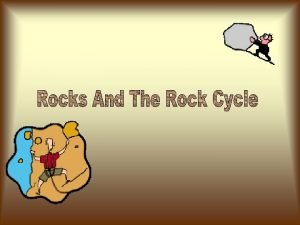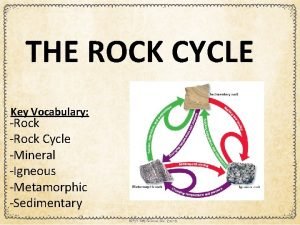THE ROCK CYCLE VOLCANISM I Introduction From Roman






























































- Slides: 62

THE ROCK CYCLE

VOLCANISM

I. Introduction From: Roman god of fire, Vulcan

I. Introduction From: Roman god of fire, Vulcan A. What is a volcano? A conical mountain formed around a vent where lava, pyroclastic materials, and gases are erupted.

I. Introduction B. Volcanic activity: – Active – Dormant – Extinct

B. Volcanic Activity 1. Active volcanoes • activity in the last few centuries Ex: Vesuvius, 79 A. D. (50 times in 2000 yr) Ex: Mt. St. Helens (1980)

B. Volcanic Activity 2. Dormant volcanoes – “quiet” for the last hundred to thousands of years, but still have potential to erupt. Mt. Rainier

B. Volcanic Activity 3. Extinct volcanoes – No eruption in historical times – No signs of erupting again

I. Introduction C. Volcano Distribution • Most volcanoes occur in one of three areas: – Circum-Pacific (i. e. The Ring of Fire) • 60% – Mediterranean • 20% – Spreading centers • 10 – 15%

Volcano Distribution

II. Volcanic materials • Three types of material expelled from volcanoes

Volcanic materials A. Lava (“the liquid”) – Molten rock

Volcanic materials A. Lava – Molten rock – Si affects viscosity

II. Volcanic materials A. Lava 1) Pahoehoe lava – Basaltic lava – Low viscosity

II. Volcanic materials A. Lava 1) Pahoehoe lava – Basaltic lava – Low viscosity – Cools moderately slowly – Ropelike appearance

II. Volcanic materials A. Lava 2) Aa lava (pronounced aa-aa) – Basaltic lava – Higher viscosity – Solidifies while flowing – Angular pieces

II. Volcanic materials A. Lava 3) Pillow lavas – Lava extruded underwater – Cools and contracts – Spherical masses – Ocean floor

II. Volcanic materials A. Lava (“the liquid”) B. Ash and pyroclastic material (“the solid”) – Airborne material ejected by a volcano – Classified based on size:

B. Ash and pyroclastic material (“the solid”) * Volcanic ash – Fine ash - <0. 06 mm – Coarse ash – 0. 06 mm to 2 mm – Composition = rock, mineral, and volcanic glass

B. Ash and pyroclastic material (“the solid”) * Cinders • 2 mm and 64 mm • Composition - same as ash • Hazardous when falling

B. Ash and pyroclastic material (“the solid”) C) Bombs – Larger than 64 mm – Molten rock solidifies in the air – Shapes vary

II. Volcanic materials C. Volcanic gases (“the gases”) – Volatiles • • • H 2 S – Hydrogen sulfide H 2 O – Water vapor SO 2 – Sulfides CO 2 – Carbon dioxide N 2 – Nitrogen HCl – Hydrochloric Acid – Significance?

II. Volcanic materials A) Determines violence of an eruption – High gas = violent eruptions – Violent eruptions = felsic magmas • High viscosity magma traps gas • Expansion is prevented, pressure builds

II. Volcanic materials B) Effects on global climate – CO 2 – Greenhouse gas – SO 2 – Blocks sunlight

II. Volcanic materials • Hazards to humans – Clouds of CO 2 get released – Travels across the ground

III. Volcanic Landforms

III. Volcanic Landforms • An erupting volcano will produce a number of distinct landforms including: A. Volcanic cones B. Flood basalts C. Calderas

A. Volcanic cones Three types of volcanic cones:

A. Volcanic cones 1) Shield volcanoes – Multiple layers of basaltic lava – Shallow sides due to magma’s low viscosity – Gentle eruptions

A. Volcanic cones 1) Shield volcanoes – Tall volcanoes – 3 or 4 miles tall – Wide base – Diameter of ten of miles

A. Volcanic cones • Mauna Loa volcano, Hawaii

A. Volcanic cones 2)Cinder cones – – Smallest volcanic cone – Layered ash and cinders Ex: El Paricutin

A. Volcanic cones 2) Cinder cones – Short, narrow cone, – Steep sides – Violent eruptions

A. Volcanic cones Lassen National Monument, CA

A. Volcanic cones 3) Composite or stratovolcanoes – – Layered ash, lava, and mud – Intermediate to felsic lava – Steep sides, due to lava’s high viscosity

A. Volcanic cones 3) Composite or stratovolcanoes – – Tall volcanoes – 1 to 2 miles high – Violent eruptions

A. Volcanic cones • Mt. St. Helens, WA

III. Volcanic Landforms B) Flood basalts – Large outpourings of basaltic lava – Multiple, quiet eruptions – Lava plateau

B) Flood basalts • A portion of the Columbia Flood Basalts in WA

III. Volcanic Landforms C) Calderas – Large depressions (> 1 km) from violent eruptions – Ugashik Caldera, AK

C) Calderas Two methods of formation: Method 1: Volcano rapidly empties its magma chamber, and support is lost

C) Calderas Method 1 (cont. ): • Overlying material collapses into magma chamber • Caldera forms

C) Calderas Ex: Crater Lake, OR

C) Calderas Two methods of formation: Method 2: Volcano blows its top, leaving behind a void Inside the cone.

C) Calderas Two methods of formation: Method 2: Volcano blows its top, leaving behind a void Inside the cone.

IV. Volcanic hazards

IV. Volcanic hazards A) Lahars (hot mud flows)

IV. Volcanic hazards • Lahars Sources of water – Melting ice caps – Excess rainfall

IV. Volcanic hazards B) Nuee Ardentes (Glowing Ash flows) – Clouds of dense gas and debris – French for “glowing cloud” – High speeds and high temperatures

IV. Volcanic hazards • How does a Nuee Ardente form? – Volcano erupts – Hot debris rises – Gravity takes over

IV. Volcanic hazards • How does a Nuee Ardente form? (cont’d) – Debris descends rapidly (200 mph) – Flows down mountain slopes – Travel up to 80 miles

IV. Volcanic hazards C) Tsunamis – Wave generated by volcanic explosion – Japanese for harbor wave

IV. Volcanic hazards • Tsunamis are extremely hazardous – Travel vast distances – Strike with short notice – Krakatoa (1883) 36, 000 people died

IV. Volcanic hazards D) Lava flows – Least dangerous – Lava flows slowly (<10 mph) – Dangerous to property

V. Predicting Eruptions • Why try to predict eruptions? – Minimize damage – Minimize loss of life • Four ways to predict an eruption:

V. Predicting Eruptions 1)Harmonic tremors – Small earthquakes – From moving magma – Last for hours

V. Predicting Eruptions 2)Increased gas emissions – CO 2 – SO 2 – H 2 S – Large tracts of healthy forests die off

V. Predicting Eruptions 3)Changes in mountain shape – Pressure from the magma deforms the mountain – Detected by tiltmeters

V. Predicting Eruptions • Tiltmeter – Tiltmeter measures ground tilt – Stable ground = zero tilt – Change from zero indicates shape change

V. Predicting Eruptions • Mt. St. Helens and the orange line

V. Predicting Eruptions 4)Observe material from past eruptions – Geologists map out past: • Lahars • Lava flows – Count number of past eruptions – Date each eruption – Calculate periodicity

VI. Benefits of Volcanoes • Benefits of volcanoes – Soils – Energy from heat – Rock (Pumice) – Gases for industry
 Intraplate volcanism
Intraplate volcanism Volcanism
Volcanism Sedimentary rock song
Sedimentary rock song Rock cycle sedimentary
Rock cycle sedimentary Compaction and cementation
Compaction and cementation Climbing rock climbing
Climbing rock climbing A rock climber's shoe loosens a rock and her climbing buddy
A rock climber's shoe loosens a rock and her climbing buddy Chapter 3 standardized test practice answers
Chapter 3 standardized test practice answers The rock cycle diagram
The rock cycle diagram Empire
Empire Roman republic vs roman empire
Roman republic vs roman empire Rock cycle comic strip
Rock cycle comic strip Metamorphic sedimentary
Metamorphic sedimentary Rock cycle learning objectives
Rock cycle learning objectives Rock cycle jeopardy
Rock cycle jeopardy Types of rocks
Types of rocks Rock cycle example
Rock cycle example Kesler science rock cycle answer key
Kesler science rock cycle answer key Types of rocks foldable
Types of rocks foldable Rock cycle
Rock cycle Concept map metamorphic rocks
Concept map metamorphic rocks Rock cycle doodle notes
Rock cycle doodle notes Jeopardy rocks
Jeopardy rocks Chapter 4 section 1 the rock cycle answer key
Chapter 4 section 1 the rock cycle answer key Lesson 2 the rock cycle answer key
Lesson 2 the rock cycle answer key Rock cycle
Rock cycle Make your own folds and faults answer key
Make your own folds and faults answer key How does soil link the rock cycle and biosphere?
How does soil link the rock cycle and biosphere? Transportation rock cycle
Transportation rock cycle Rock cycle ngss
Rock cycle ngss Rock cycle project
Rock cycle project Https://geology.com/rocks/
Https://geology.com/rocks/ Energy in the rock cycle
Energy in the rock cycle Igneous rock comic strip
Igneous rock comic strip Igneous sedimentary and metamorphic
Igneous sedimentary and metamorphic The rock cycle
The rock cycle Learner org rock cycle
Learner org rock cycle Rock types and cycle quick check
Rock types and cycle quick check Parent rocks of marble
Parent rocks of marble Sedimentary rock
Sedimentary rock Brainpop rock cycle
Brainpop rock cycle Solid rock
Solid rock Metamorphic grade
Metamorphic grade Earth science
Earth science Rock formation cycle
Rock formation cycle Rock cycle
Rock cycle Quartzite rock cycle
Quartzite rock cycle Activeartto
Activeartto Rock cycle
Rock cycle Rock cycle jeopardy
Rock cycle jeopardy Metamorphic rocks images with names
Metamorphic rocks images with names Rock cycle
Rock cycle Rock cycle
Rock cycle Rock cycle
Rock cycle Foliated metamorphic rocks
Foliated metamorphic rocks Rock cucle
Rock cucle Intrusive igneous rocks texture
Intrusive igneous rocks texture Define a rock cycle
Define a rock cycle Types of rocks foldable
Types of rocks foldable Hát kết hợp bộ gõ cơ thể
Hát kết hợp bộ gõ cơ thể Slidetodoc
Slidetodoc Bổ thể
Bổ thể Tỉ lệ cơ thể trẻ em
Tỉ lệ cơ thể trẻ em
